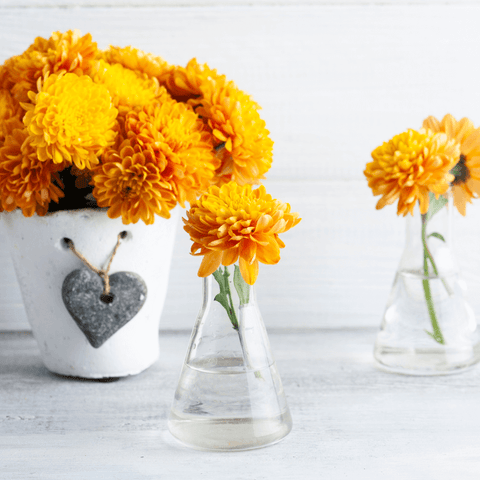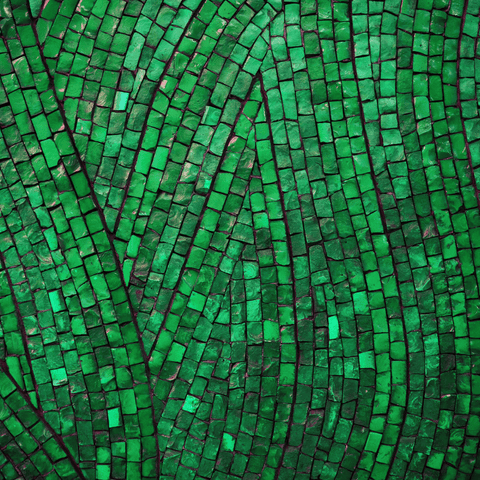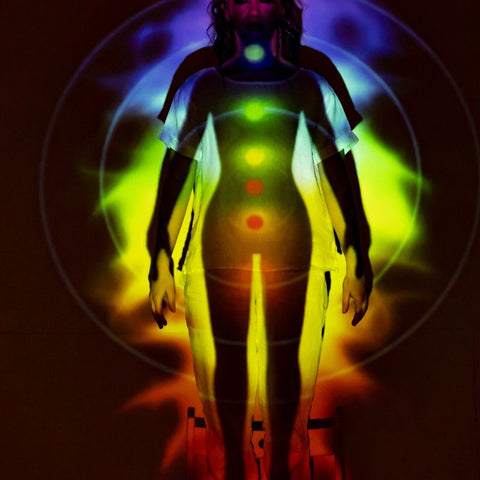A Spoonful Of Color - 8 Heavenly Colors For Therapy
The spectrum of colors in visible light are known for their interesting and unique properties.
Every color is different, and holds its own special power and influence over different aspects of the body.
Colors have been used to influence and improve people's health for thousands of years, but if you're unfamiliar with forms of color therapy then you may be completely unaware of the healing properties that different colors contain.
If you're interested in learning more about the healing power of colors, then you've come to the right place.
In this guide we'll take you through the basics of color therapy, as well as how each color is able to heal your body, mind, and spirit.
We'll also take a look at some other ways colors can produce healing effects, such as through crystals and chakras. So let's get started!
What Is Color Therapy?
Color therapy (also known as chromotherapy) is a form of healing that uses the spectrum of colors in various ways to cure illness and disease.
Chromotherapy has existed in different forms for thousands of years, and the healing powers of colors are still used to this day.
While simplified forms of chromotherapy were used in the hermetic traditions of Ancient Egypt and Greece, it's only been in the last few centuries that the true potential of color healing has presented itself.
Chromotherapists such as Augustus Pleasonton and Edwin Dwight Babbitt helped to pioneer modern color therapy, and chromotherapy has risen in popularity as a form of alternative medicine.
There are two main forms of chromotherapy: visual therapy, and colored light therapy.
Visual color therapy involves looking at certain colors to elicit emotional reactions.
Light chromotherapy uses different colored lights, which are used to illuminate a room or shone directly onto parts of the body in order to heal and benefit the person.
Different colors have different uses; red, for example, can energize and promote vitality, while blue is calming and relaxing.

The Best Healing Colors
Now that we know a bit more about what color therapy is and how it works, it's time to take a closer look at what colors are used in chromotherapy.
Here we'll go over each color, touching on its healing properties, how it's used, and the illnesses each color is used to treat.
1) Red- Colors for Therapy
Red is one of the most commonly used colors in color therapy. Red is used to energize the body, particularly the heart and (to a lesser extent) the nerves.
It also stimulates the mind by promoting mental clarity and concentration.
Red helps with blood circulation, digestion, and metabolism. It promotes strength and endurance, and it increases energy levels.
In addition, red is often used to help people who suffer from depression.
In chromotherapy, red light is shone on the body to stimulate blood flow, increase your energy, and improve overall health.
However, red light isn't always useful, and there are times when it should be avoided.
Because red increases blood pressure and raises adrenaline levels, patients suffering from high stress or tension may actually get worse if exposed to red light.
2) Orange- Colors for Therapy
Orange is another popular color in chromotherapy. Like red, orange is used to energize and strengthen the body.

However, while red is attributed with blood and the heart, orange is linked more to the nerves. This warm color radiates joy and a gentle warmth, which makes it both comforting and energizing.
Orange is also akin with creativity and imagination.
It is a great color for use during chromotherapy if you're feeling lethargic or run down, because it increases vitality and refreshes the nervous system.
Orange light also has many benefits for your kidneys and liver, both of which help to detox the body and keep your immune system in good shape.
Because of orange's warmth and feel-good energy, it's one of the best color choices to use in hospitals.
Its comforting and energizing nature helps to bolster recovery and improve mood, and orange light can be in use to heal both the body and mind.
With that said, however, orange light can also make nausea and headaches worse, and should be in avoidance with patients with these symptoms.
3) Yellow- Colors for Therapy
Yellow takes orange's comforting warmth and combines it with positivity and tons of bright energy.
The two are similar in many ways, although there are slight differences between them in several aspects.
Like orange light, yellow is an energizing color that inspires creativity and removes lethargy. However, while orange stimulates the nerves, yellow stimulates the brain.
This bright, sunny color is perfect for use in hospitals, where it can promote relaxation and calmness.
It's also ideal for use with children, as it encourages their curiosity and inspires them to learn new things.
Yellow is also beneficial for its detoxifying properties, which help to put the spring back in your step.
As such a bright color, yellow can be overwhelming if used in excess.
Yellow should be in use sparingly in chromotherapy sessions, as too much yellow light causes an overactive brain that can lead to issues such as insomnia and restlessness.
4) Green- Colors for Therapy
Green harnesses the healing powers of nature, bringing about balance and growth. It's a calming color that soothes and relaxes the body, helping to relieve anxiety and stress.

Green is to boost memory and concentration, making it a great choice for anyone looking to sharpen their focus.
Unlike the previous colors we've covered, green is a restful color that brings peace and equilibrium.
While red, orange, and yellow are all bright and energizing colors that boost the body, green is all about bringing you back into balance.
Green light encourages healing throughout the body, most notably in the respiratory and circulatory systems.
As the color associated with the heart chakra, green nourishes and nurtures the emotional side of our being.
While green light is often recommended for people who suffer from depression, it can have some negative effects when used excessively.
Because it promotes relaxation and balances emotions, it can cause feelings of heaviness, sadness, and lethargy if used in excess. Like its powers, green should be in moderation.
5) Blue- Colors for Therapy
Blue is another color that promotes peace and tranquility. It calms the soul and encourages introspection, allowing us to get to know ourselves better.

This deep, tranquil hue is a great choice for those looking to clear their minds and find clarity.
In chromotherapy, blue help reduce stress and relax the muscles. Its cooling and calming effects also lower blood pressure and slow a rapid pulse.
Moving towards the higher chakras, calming colors such as blue are less focused on healing the body as they are for healing the mind and spirit.
However, blue's relaxing properties also reduce inflammation of muscles, loosen stiff joints, and soothe a sore/swollen throat (as blue is the color of the throat chakra).
Blue light is well-known for having a negative influence on sleep, and should be avoided late at night to reduce the risk of insomnia.
Its calming effect can also be too much, and while blue is great for reducing stress and tension it can also deepen feelings of sadness and depression.
6) Purple- Colors for Therapy
Purple is one of the most powerful colors in the spectrum. It increases energy levels, improve moods, and even enhance creativity.
This vibrant, intense color is best suited for those looking to stimulate the mind and spirit, as opposed to the body.
Various shades of purple, such as violet or lilac, hold different powers; intense and saturated shades hold a greater stimulating effect, while softer tones help to relax and cleanse the mind.
When it comes to the healing power of purple, many practitioners of chromotherapy point towards the higher chakras as having the strongest healing influences.
Violet is the color of the crown chakra, the highest chakra in the body and the one associated most with spirituality and higher consciousnesses.
This means that (outside chromotherapy) purple is best in use in meditation to help focus the mind.
Purple light stimulate and cleanse the mind of negative influences, and bolster the nervous system.
It has a connection to the cerebral system, which controls muscles and (to a much greater extent) is mainly in charge of the consciousness.
By using purple light in chromotherapy, you can improve perception, insight, and experience a stronger or higher state of consciousness.
RELATED: 73 UPLIFTING AFFIRMATIONS TO INSPIRE POSITIVE THINKING
7) Pink- Colors for Therapy
As a color, pink is typically in connection with love and romance. However, pink also has several healing qualities.

Similarly to red, pink fosters healing and happiness; but unlike red, pink is a much more gentle and kind color that departs from the intensity brought by red light.
In fact, pink has the opposite effect, and is able to reduce stress and calm both the body and mind.
Pink is all about compassion, and this shines through with the soothing healing it produces. It also elicits feelings of joy and self-love, without the strong emotions of red and yellow.
When it comes to creating stronger energies, pink is able to create and bolster feelings of love and care, which more intense shades of pink can turn into a burning passion.
Too much pink can become bittersweet or lead to erratic behavior, so it should be in moderation.
Pink light can have the opposite of its intended effect if used in the wrong situations, and can actually be more aggravating than relaxing in the wrong cases.
8) White- Colors for Therapy
White light is considered to be light's purest form. It is a combination of all other colors in an equal balance, and is mostly tied to cleansing and purification.
In color healing, white clears away any negativity or impurities, and to bring about peace and harmony.
It has a host of physical benefits too, from revitalizing the body to promoting a strong recovery.
One of the most interesting qualities of the color white in chromotherapy is that it amplifies the effects of other colors used with it.
By boosting the power of certain colors, white light is able to speed up recovery and alleviate symptoms far more effectively.
This does mean a more intense light, however, and white shouldn't be in use constantly to prevent the risk of it being overwhelming.
Colors, Crystals, And Chakras
There are many ways colors can promote good health besides using in chromotherapy.
Two of the biggest implementations of colors in other facets of alternative medicine are their associations with crystals and chakras.
Chakras
We've mentioned chakras several times when going over these healing colors.

Chakras are points of energy located along the spine, each with their own purpose and function relating to your physical, emotional, and spiritual health.
There are 7 chakras, and each one is assigned a color of the rainbow; these go in order from red for the root chakra (the lowest chakra at the base of your spine). Then, through to violet for the crown chakra (the highest one which lies at the top of your skull).
Using different colors can help to activate and amplify the effects of each chakra.
By combining various colors through the use of lights, crystals, or other forms, you can influence your chakras to achieve inner balance and promote good health.
This ties into chromotherapy, as using colors to activate your chakras can produce different health benefits when done correctly.
Crystals
Closely in connection to the healing power of colors are crystals. Crystals come in all shapes and sizes, but their colors are the clearest indicator of the effects they can produce.
Similarly to chakras, different colors have different influences over your body; in fact, crystals are often in use to activate or stimulate the chakra that their color have a connection to.
The use of crystals for healing has existed for thousands of years. And they are still in use to varying degrees today.
By wearing, holding, or being in proximity to crystals of a certain color, you can absorb the healing energy within that crystal.
Jewelry in particular makes it easy to incorporate forms of chromotherapy into your everyday life. And using colored crystals can help you reap the color's benefits to your body, mind, and spirit.
Final Thoughts
Now you know a bit more about the healing powers of colors. Furthermore, from the effects they produce to the parts of the body each color has a connection to.
There are still so much we don't yet understand about colors and their healing benefits. But through chromotherapy and other alternative medicine, you can use colors for a quick recovery and a strong, healthy body.
Colors are full of potential when it comes to healing, and there are plenty of ways to harness them to benefit yourself.
By using these colors in your everyday life, you help to enrich and heal your body, mind, and spirit. So what are you waiting for?

